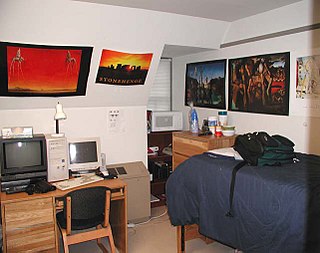
A dormitory is a building primarily providing sleeping and residential quarters for large numbers of people such as boarding school, high school, college or university students. In some countries, it can also refer to a room containing several beds accommodating people.
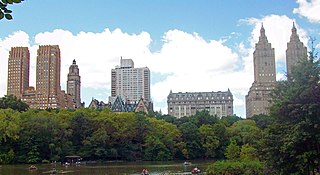
A housing cooperative, or housing co-op, is a legal entity, usually a cooperative or a corporation, which owns real estate, consisting of one or more residential buildings; it is one type of housing tenure. Housing cooperatives can be owned by a non-profit organization or by shareholders, they are a distinctive form of home ownership that have many characteristics that differ from other residential arrangements such as single family home ownership, condominiums and renting.
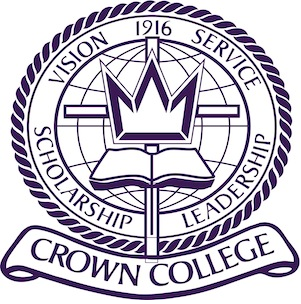
Crown College is a private Christian college in St. Bonifacius, Minnesota. It is affiliated with the Christian and Missionary Alliance and is accredited by the Higher Learning Commission.

Single room occupancy is a form of housing that is typically aimed at residents with low or minimal incomes who rent small, furnished single rooms with a bed, chair, and sometimes a small desk. SRO units are rented out as permanent residence and/or primary residence to individuals, within a multi-tenant building where tenants share a kitchen, toilets or bathrooms. SRO units range from 7 to 13 square metres. In some instances, contemporary units may have a small refrigerator, microwave, or sink.

The University of Dayton Ghetto, officially the Student Neighborhood, located in Dayton, Ohio, is home to upperclassmen at the University of Dayton (UD). Housing in "the Ghetto" is leased in an arrangement that resembles both traditional university housing and a landlord/tenant relationship. Tracing its history back to the 1870s, the neighborhood now includes more than 200 university-owned houses as well as landlord-owned houses, high-density housing and gathering spaces. With the inclusion of Holy Angels and The Darkside, or officially "the North Student Neighborhood", two smaller neighborhoods the university owns property in, there are more than 400 houses currently used as student residential space. Because of the area's age, the university has been engaged in a program to renovate and update the houses, and several additional changes to the neighborhood are expected in the coming years as part of the university's Master Plan.
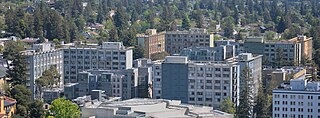
Housing at the University of California, Berkeley, includes student housing facilities run by the office of Residential and Student Service Programs (RSSP). Housing is also offered by off-campus entities such as fraternities and sororities and the Berkeley Student Cooperative (BSC).
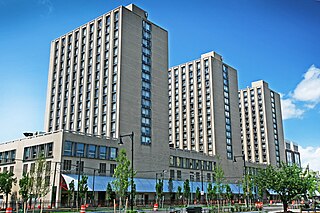
The Boston University housing system is the 2nd-largest of any private university in the United States, with 76% of the undergraduate population living on campus. On-campus housing at BU is an unusually diverse melange, ranging from individual 19th-century brownstone town houses and apartment buildings acquired by the school to large-scale high-rises built in the 60s and 2000s.
Student housing at the University of California, Irvine is separated between freshmen, continuing students, graduate students, and faculty. These accommodations serve a traditional purpose of housing residents, but also serve as a long-term outreach incentive for new freshmen and faculty. Student housing also play a key role in developing campuswide social activities.

Housing at the Massachusetts Institute of Technology (MIT) consists of eleven undergraduate dormitories and nine graduate dorms. All undergraduate students are required to live in an MIT residence during their first year of study. Undergraduate dorms are usually divided into suites or floors, and usually have Graduate Resident Assistants (GRA), graduate students living among the undergraduates who help support student morale and social activities. Many MIT undergraduate dorms are known for their distinctive student cultures and traditions.

Student housing owned by the University of California, Los Angeles is governed by two separate departments: the Office of Residential Life, and Housing and Hospitality Services, and provides housing for both undergraduates and graduate students, on and off-campus.

Bouquet Gardens is a major student residential complex of the University of Pittsburgh consisting of eight, 4-story garden-style gabled-roofed apartment buildings clustered around progression of courtyards connected by an interior pathway as well as a four-story apartment-style residence hall. Each gabled-roofed apartment-style building contains sixteen 4-bedroom apartments while the 155 bed Building J contains amenities for use by residents of the entire complex. Designed by Renaissance 3 Architects, P.C., the combined complex houses 651 upper-level undergraduate students in 172 units located on the lower campus close to Posvar Hall, the Barco Law Building, and adjacent to Sennott Square.

The Pymatuning Laboratory of Ecology (PLE) is a year-round ecology field station of the University of Pittsburgh Department of Biological Sciences located in Linesville and South Shenango Township on the shores Pymatuning Lake in Pennsylvania. The station contains research facilities and equipment, conducts undergraduate education and courses, and serves as center for conferences, symposia, and retreats. The Pyatuning Laboratory hosts researchers from the University of Pittsburgh as well as those from universities throughout the nation and world, which have included, among others, researchers form Duke University, the University of Virginia, the University of Georgia, the University of Miami. Likewise, course instructors at the lab come from the University of Pittsburgh, but also have included instructors from other institutions including Georgia Tech, the University of Connecticut, and the National Aviary. In addition, the University of Pittsburgh has instituted a collaborative program for study at the Pymatuning Lab with other area universities in which students that are enrolled through any of these institutions register, pay tuition, and receive credit at their home institutions. Schools participating in the collaborative program include Clarion University, Edinboro University, Indiana University of Pennsylvania, and Slippery Rock University.

Housing at the University of Chicago includes seven residence halls that are divided into 48 houses. Each house has an average of 70 students. Freshmen and sophomores must live on-campus. Limited on-campus housing is available to juniors and seniors. The university operates 28 apartment buildings near campus for graduate students.

Fifteen percent of University of Houston students live on campus. UH has several on campus dormitories: Moody Towers, The Quads, Cougar Village I, Cougar Village II, Cougar Place, and University Lofts. UH also has partnerships with three private complexes, Bayou Oaks, Cullen Oaks, and Cambridge Oaks.

A microapartment, also known as a microflat, is a one-room, self-contained living space, usually purpose built, designed to accommodate a sitting space, sleeping space, bathroom and kitchenette with 14–32 square metres. Unlike a traditional studio flat, residents may also have access to a communal kitchen, communal bathroom/shower, patio and roof garden. The microapartments are often designed for futons, or with pull-down beds, folding desks and tables, and extra-small or hidden appliances. They differ from bedsits, the traditional British bed-sitting room, in that they are self-contained, with their own bathroom, toilet, and kitchenette.
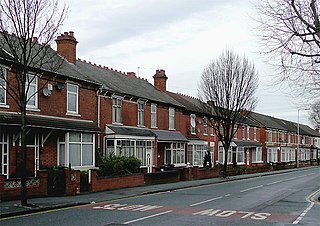
Housing in the United Kingdom represents the largest non-financial asset class in the UK; its overall net value passed the £5 trillion mark in 2014. About 30% of homes are owned outright by their occupants, and a further 40% are owner-occupied on a mortgage. About 18% are social housing of some kind, and the remaining 12% are privately rented.